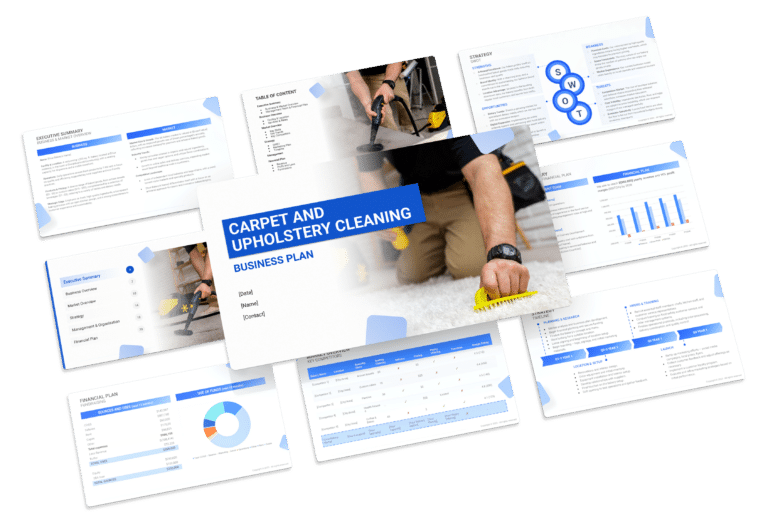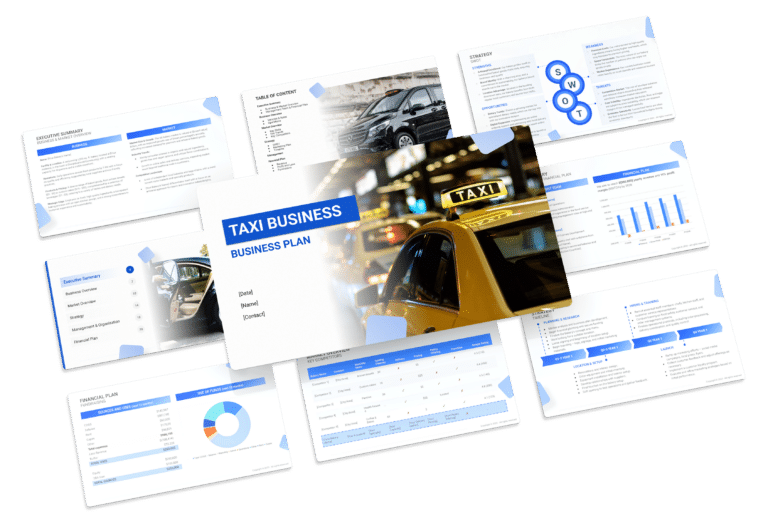Waste Management Business Plan Template & PDF Example

Creating a comprehensive business plan is crucial for launching and running a successful waste management business. This plan serves as your roadmap, detailing your vision, operational strategies, and financial plan. It helps establish your waste management business’s identity, navigate the competitive market, and secure funding for growth.
This article not only breaks down the critical components of a waste management business plan, but also provides an example of a business plan to help you craft your own.
Whether you’re an experienced entrepreneur or new to the service industry, this guide, complete with a business plan example, lays the groundwork for turning your waste management business concept into reality. Let’s dive in!
The Plan
Our waste management business plan is structured to address all key components necessary for a detailed and strategic approach. It outlines the company’s operational methods, marketing strategies, market environment, competitors, management team, and financial projections.
- Executive Summary: Offers an overview of the waste management company’s business model, emphasizing its commitment to providing comprehensive waste management solutions, market analysis, management expertise, and financial strategy.
- Business Overview: Provides a detailed look at the operational aspects and the services offered by the waste management company, setting the groundwork for its market operations.
- Operations & Service Area Coverage: Discusses the operational scope, including the geographical coverage of services, types of waste managed, and the company’s operational facilities and capabilities.
- Services & Rates: Details the waste management services offered, such as collection, recycling, hazardous waste handling, and their associated pricing structure.
- Market Overview: Presents an in-depth analysis of the waste management industry, identifying the company’s position within the competitive landscape.
- Key Stats: Provides essential statistics that illustrate the size and growth of the waste management industry, highlighting the ongoing demand for such services.
- Key Trends: Highlights significant trends in waste management, including technological advancements, regulatory changes, and shifts towards sustainability.
- Key Competitors: Evaluates major competitors in the market, detailing their services and how the company differentiates itself from these competitors.
- Strategy: Outlines the strategic framework the waste management company will employ to navigate the industry and achieve its business objectives.
- SWOT Analysis: Conducts a thorough analysis of strengths, weaknesses, opportunities, and threats, offering strategic insights for the company’s growth.
- Marketing Plan: Specifies the marketing strategies designed to promote the waste management services and establish long-term relationships with clients.
- Timeline: Sets key milestones for the waste management company, outlining the path from startup to expansion and operational excellence.
- Management: Introduces the management team, highlighting their experience, roles, and contributions to driving the company towards its goals.
- Financial Plan: Forecasts the financial performance of the waste management company, detailing expected revenue streams, profitability, and the financial strategy to ensure sustainability and growth.

Executive Summary
The Executive Summary introduces your waste management business plan, offering a concise overview of your company and its services. It should detail your market positioning, the range of waste collection, recycling, and disposal services you offer, its location, capacity, and an outline of day-to-day operations.
This section should also explore how your waste management business will integrate into the local market, including the number of direct competitors within the area, identifying who they are, along with your company’s unique selling points that differentiate it from these competitors.
Furthermore, you should include information about the management and co-founding team, detailing their roles and contributions to the company’s success. Additionally, a summary of your financial projections, including revenue and profits over the next five years, should be presented here to provide a clear picture of your company’s financial plan.
Waste Management Business Plan Executive Summary Example

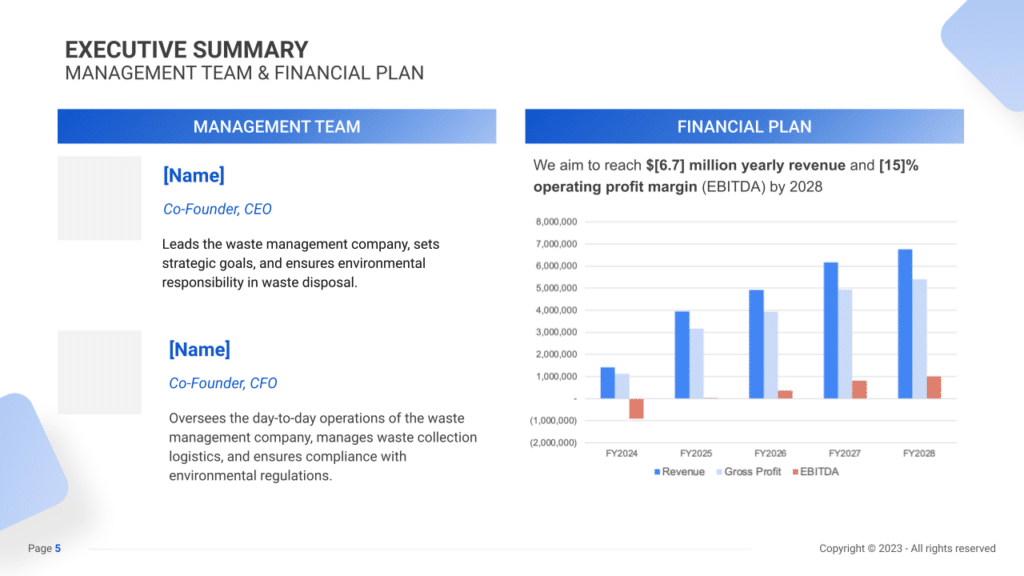
Business Overview
In the business overview section of your executive summary, provide clear and direct information about your waste management service. This should include your company’s name, the regions you serve, the services you offer, and a snapshot of your operations.
This section introduces your business and sets the stage for discussing its unique attributes. Your unique selling proposition (USP) is what differentiates your service from others in the industry. Whether it’s your advanced technology, commitment to zero-waste goals, or custom solutions for different waste types, your USP should grab your audience’s attention and highlight the value your service brings to the waste management market.
Example:
“GreenHorizon Waste Solutions,” serving the tri-state area, offers a comprehensive suite of waste management services, including recycling, composting, and hazardous waste handling. With a capacity to process over 5,000 tons of waste daily, our USP is our innovative approach to waste minimization and our state-of-the-art recycling technology, which significantly reduces landfill reliance.
Market Overview
It’s important to outline the waste management industry’s size, growth trends, and dynamics, using data such as market value and growth rates. Highlighting trends like the adoption of smart waste solutions and the shift towards sustainable practices can give insight into the industry’s direction and your company’s role within it.
The competitive landscape should also be addressed. Here, you’ll identify your main competitors and explain how your service stands out, whether through unique waste processing methods, customer service excellence, or environmental stewardship.
Example:
GreenHorizon operates in the $140 billion waste management industry, expected to grow at a 5% CAGR through 2030. Despite competition, GreenHorizon distinguishes itself with its focus on advanced waste processing technologies and custom solutions, catering to the specific needs of residential, commercial, and industrial clients.
Management Team
The expertise and background of your management team are key assets. Highlight the qualifications and experiences of your team members, emphasizing the industry knowledge and leadership driving your business.
Example:
The GreenHorizon team is led by founders Alex Reed and Jamie Chen. Alex brings over 20 years of experience in environmental engineering, while Jamie’s expertise in sustainable business practices and regulatory compliance sets a strong foundation for GreenHorizon’s operations and growth.
Financial Plan
Summarize your financial goals and projections, including revenue targets and profit margins, to provide a clear overview of your waste management service’s financial future.
Example:
GreenHorizon aims to achieve $6.7 million in annual revenue by 2028, with a 15% EBITDA margin. Our financial strategy focuses on expanding our service offerings and enhancing our processing capabilities, driving growth and efficiency while upholding our commitment to environmental sustainability.
Business Overview
For a waste management business, the Business Overview section can be concisely divided into 2 main slides:
Operations & Service Area Coverage
Detail the operational aspects of your waste management business, emphasizing the efficiency, reliability, and environmental compliance of your services. Mention the geographical scope of your service area, highlighting its extent and the variety of communities or businesses you serve.
Explain why your operations are strategically located to optimize service delivery and logistical efficiency, such as proximity to major highways or waste processing facilities. Discuss how your operational capabilities and service area coverage position your business to meet the needs of your target market effectively.
Services & Rates
Outline the range of waste management services offered, from regular residential waste collection to specialized services like recycling, hazardous waste disposal, or commercial waste management solutions.
Detail your pricing strategy, ensuring it is competitive and reflects the value of the services you provide, taking into consideration factors like service frequency, waste type, and volume. Highlight any unique service offerings, subscription models, or incentive programs for waste reduction and recycling that distinguish your business from competitors, promoting sustainability and customer engagement.

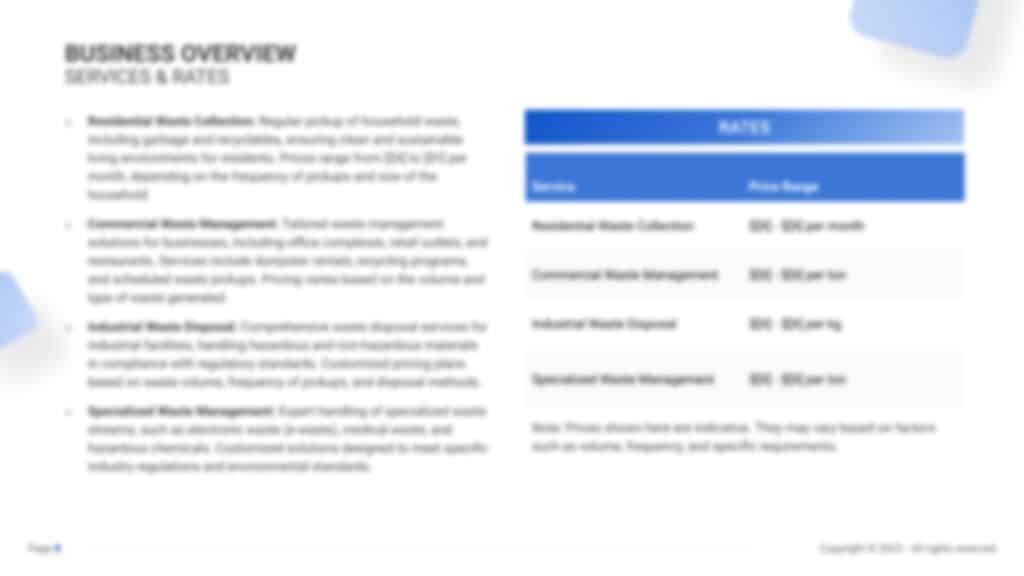
Market Overview

Industry size & growth
In the Market Overview of your waste management business plan, begin by analyzing the size of the waste management industry and its growth potential. This exploration is vital for grasping the market’s breadth and pinpointing opportunities for expansion.
Key market trends
Next, delve into recent trends within the waste management sector, such as the escalating demand for sustainable and eco-friendly waste disposal methods, advancements in recycling technologies, and the increasing importance of waste-to-energy solutions.
For instance, underscore the growing consumer and corporate emphasis on reducing environmental impact, which has led to a heightened demand for services capable of managing recyclable, compostable, and hazardous waste more effectively.
Competitive Landscape
A competitive analysis is not just a tool for gauging the position of your waste management business in the market and its key competitors; it’s also a fundamental component of your business plan. This analysis helps in identifying your waste management’s unique selling points, essential for differentiating your business in a competitive market.
In addition, the competitive analysis is integral in laying a solid foundation for your business plan. By examining various operational aspects of your competitors, you gain valuable information that ensures your business plan is robust, informed, and tailored to succeed in the current market environment.
Identifying Your Competitors in the Waste Management Industry
Begin your competitive analysis by identifying the key players in the waste management sector. Local waste disposal companies, recycling facilities, and waste management services are your immediate competitors. Take note of both direct competitors, like other waste management companies in your region, and indirect competitors, such as companies offering specialized recycling services or innovative waste reduction solutions.
Utilize online resources and industry databases to compile a comprehensive list of competitors. Platforms like industry forums, government waste management reports, and customer reviews can offer valuable insights into the strengths and weaknesses of your competitors. For instance, positive reviews highlighting the efficiency and eco-friendly practices of a competitor could indicate a significant strength.

Waste Management Business Competitors’ Strategies
To analyze your competitors effectively, consider various aspects of their strategies:
- Waste Management Services: Examine the range of services offered by competitors. If a waste management company, like “Eco Solutions,” is gaining traction for its comprehensive recycling programs, this suggests a market trend toward sustainability and eco-conscious waste management.
- Technology and Innovation: Assess the technological advancements and innovative practices adopted by competitors. A waste management company employing state-of-the-art waste sorting technologies or implementing smart waste collection systems may have a competitive edge.
- Pricing Structure: Compare your pricing structure with that of your competitors. Are your waste management services priced competitively with other local companies, or do you position yourself as a premium service with enhanced features like “Efficient Waste Solutions”?
- Marketing Strategies: Investigate how competitors market their services. Do they rely on digital marketing, social media, or community outreach programs? Understanding their marketing tactics can help you refine your own strategies to reach and engage your target audience effectively.
- Customer Satisfaction: Evaluate the customer experience provided by competitors. A waste management company known for its prompt and reliable service, or one with excellent customer support, may have a distinct advantage.
- Environmental Commitment: Assess the environmental sustainability practices of competitors. In a market increasingly concerned with eco-friendly solutions, a waste management company with a strong commitment to environmental responsibility may have a competitive edge.
What’s Your Waste Management Business’s Value Proposition?
Reflect on your waste management business’s unique value proposition. Perhaps your company specializes in innovative waste-to-energy solutions, or you prioritize community engagement and educational programs to promote responsible waste disposal.
Identify market gaps through customer feedback and industry trends. For instance, if customers express a growing demand for streamlined electronic waste recycling and your competitors are not fully addressing this need, it represents an opportunity for your business to stand out.
Consider your location and target market. A waste management company operating in an industrial area might emphasize industrial waste solutions, while one in a residential neighborhood could focus on household recycling initiatives.
Strategy

SWOT
Begin by executing a SWOT analysis for your waste management business, pinpointing Strengths (such as advanced recycling technology and comprehensive waste solutions), Weaknesses (including high initial investment costs or stringent regulatory compliance), Opportunities (for instance, the growing emphasis on sustainable practices and green energy), and Threats (such as shifts in environmental policies that could impact operational costs).

Marketing Plan
Then, formulate a marketing plan that details strategies for engaging and expanding your customer base through focused advertising campaigns, service promotions, an active online presence, and participation in environmental initiatives. Highlight how these efforts will not only raise awareness of your waste management solutions but also underscore your commitment to sustainability and community well-being.
Marketing Channels
Utilize various marketing channels to reach your target audience, increase brand visibility, and showcase your waste management solutions.
Digital Marketing
- Website and SEO: Develop an informative website emphasizing your services, expertise, case studies, and industry insights. Optimize it for search engines to enhance online visibility.
- Content Marketing: Create engaging blog posts, whitepapers, and infographics focusing on waste management trends, recycling guides, and sustainability practices to position your business as an industry thought leader.
- Social Media: Harness social media platforms such as LinkedIn, Twitter, and Instagram to disseminate educational content, success stories, client testimonials, and updates about waste management innovations.
Local Networking and Outreach
- Industry Events: Participate in environmental and waste management conferences, workshops, and trade shows to network with potential clients, industry experts, and government officials.
- Community Engagement: Collaborate with local authorities, educational institutions, and environmental groups to organize clean-up drives, awareness campaigns, or workshops on waste reduction and recycling.
Promotional Activities
Engage your target audience through appealing offers and initiatives to drive interest in your waste management services.
- Tailored Solutions: Offer customizable waste management plans catering to specific client needs, such as recycling optimization, hazardous waste disposal, or sustainable waste-to-energy solutions.
- Free Consultations: Offer complimentary waste audits or consultations to potential clients. This not only showcases your expertise but also allows you to understand their specific needs, thereby tailoring solutions that align with their objectives and challenges.
- Referral Programs: Encourage existing clients or industry partners to refer your services by offering incentives such as discounts, additional services, or loyalty rewards for successful referrals. Consider implementing a structured and mutually beneficial referral program that acknowledges and rewards those who bring in new business.
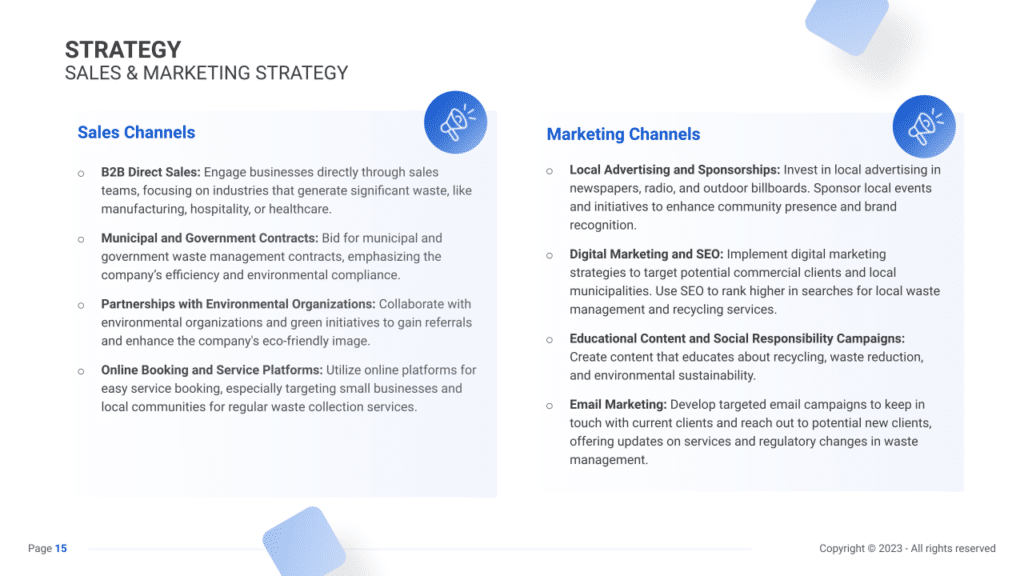
Sales Channels
Implement effective sales strategies to convert leads into clients and maximize revenue opportunities.
- Consultative Selling: Continue to educate potential clients about the significance of proper waste management practices, elucidating the environmental benefits, cost savings, and long-term advantages through personalized consultations. Showcase expertise and commitment by offering in-depth discussions on waste management strategies tailored to the client’s unique needs and objectives.
- Customized Proposals: Elevate your proposals by providing detailed and personalized waste management strategies, inclusive of cost breakdowns and projected outcomes aligned precisely with the client’s goals and operational requirements. This reinforces transparency and professionalism, instilling confidence in your company’s ability to deliver results.
- Service Bundling and Add-Ons: Showcase the versatility and additional value your services offer by bundling waste management services or providing value-added offerings. Consider providing ongoing waste reduction monitoring, educational workshops, or comprehensive sustainability reports, positioning your services as holistic solutions that go beyond mere waste disposal.
Client Retention Strategies
- Regular Follow-ups: Strengthen relationships with clients by maintaining consistent communication channels. Beyond initial transactions, keep clients engaged through newsletters, industry updates, and tips for optimizing their waste management processes. Ensure they stay informed about regulatory changes and industry trends.
- Exceptional Customer Service: Uphold a reputation for exceptional customer service by being responsive, proactive, and empathetic. Address any concerns promptly, seek feedback regularly, and actively work towards resolving any issues that may arise. Aim for a seamless and positive client experience throughout their engagement with your waste management services.
Strategy Timeline
Conclude with a comprehensive timeline that maps out key milestones, from the launch of your waste management services and marketing initiatives to customer acquisition and potential service expansion. This timeline should serve as a roadmap, guiding your business towards achieving its short and long-term goals with clarity and strategic focus.

Management
The Management section focuses on the waste management business’s management and their direct roles in daily operations and strategic direction. This part is crucial for understanding who is responsible for making key decisions and driving the waste management business toward its financial and operational goals.
For your waste management business plan, list the core team members, their specific responsibilities, and how their expertise supports the business.


Financial Plan
The Financial Plan section is a comprehensive analysis of your financial projections for revenue, expenses, and profitability. It lays out your waste management business’s approach to securing funding, managing cash flow, and achieving breakeven.
This section typically includes detailed forecasts for the first 5 years of operation, highlighting expected revenue, operating costs and capital expenditures.
For your waste management business plan, provide a snapshot of your financial statement (profit and loss, balance sheet, cash flow statement), as well as your key assumptions (e.g. number of customers and prices, expenses, etc.).
Make sure to cover here
_ Profit and Loss
_ Cash Flow Statement
_ Balance Sheet
_ Use of Funds






